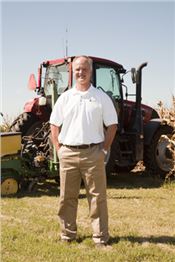|
Behind The Soil Test Numbers

Dr. Gene Stevens, Professor of Plant Science, University of Missouri, discusses the challenge
of finding inputs that can be cut without sacrificing crop yields.
Photo by John LaRose, Jr.
DR. GENE STEVENS
PORTAGEVILLE, MO.
Prices of many commodities are at their lowest level in recent years. To turn a profit in 2017, farmers will need to sharpen their pencils. The challenge is find inputs that can be cut without sacrificing crop yields.
Fat in crop budgets will be hard to find. Growers may consider reducing fertilizer inputs. However, annual tons of phosphorus (P) and potassium (K) fertilizer applied in the US have remained the same for three decades despite higher yields from improved genetics and management. With the extra bushels or pounds of lint produced, more nutrients were removed from fields. Studying soil test field records is a good way to learn the nutrient status in your fields.
I recommend looking at the raw test numbers in soil test reports not just the recommended P2O5 and K2O fertilizer rates. Test values are shown in extractable pounds of P and K per acre or ppm (parts per million). To convert ppm to pounds per acre multiply by 2.
Soil test phosphorus results are fairly straightforward. Depending on the extracting solution used by the soil test lab, fields should be maintained above 45 to 50 pounds of P per acre. Above that target level, farmers are unlikely to see any yield increase in a field by applying more fertilizer. In graphs from research P trials, yields often fall close to the curves without much scatter. It would be nice if all nutrient tests were that simple.
Soil test potassium is more complicated. The critical target level used at the University of Missouri soil lab is 220 + 5 x CEC (cation exchange capacity). Unless a soil is unusually high in organic matter, a typical loamy sand CEC in Missouri is 8. Clay loams are usually around 30. For many fields, 300 pounds of soil test K per acre is a good target. MU labs use ammonium acetate to extract for K while many private labs use Mehlich 3. A comparison between 81 labs in 2015 showed Mehlich 3 averaged 4 percent higher than with ammonium acetate. The difference between methods is not much.
Why is CEC important? CEC is a measure of the negative charge in soils and clay is major contributor. Generally, clay content increases proportional with CEC. Many clay minerals have a “wedge” interlayer that can fix potassium ions making them unavailable to plants. But, fixed K is not “Super Glued” inside the clay. In wet soil conditions, the wedge can open up making the K ions exchangeable again.
Dr. Don Howard at the University of Tennessee in Jackson studied potassium response in cotton for many years. His yield graphs with potassium across years looked a little like a shotgun pattern. You can see a definite curve in his results but it is not as tight as a typical phosphorus yield curve. In Missouri, I found similar results with my field experiments.
What makes potassium different from phosphorus? Aside from the clay wedge factor mentioned earlier, potassium is more sensitive to depth of sampling and moisture changes in the soil environment. Be careful how deep you push the soil probe during sampling. Soil K levels are usually highest at the surface and decline with depth. Just one inch can matter. A sample collected from 0 to 5 inches at the same spot will usually be higher in potassium than a sample from 0 to 6 inches.
In most labs, soil samples are placed in a drier overnight before grinding and testing. You would think that the moisture conditions in a field prior to sampling would not matter. Put it does.
Dr. Ted Peck at the University of Illinois conducted a nine year experiment collecting soil samples twice per month (12 months per year x 2 samples per month x 9 years=216 sample dates). That was dedication. In the study, he analyzed nutrients and also measured soil moisture. Dr. Dave Franzen, his former graduate student, organized and published his results. He found a seasonal up and down cycle in soil test K levels which he correlated with soil moisture. Generally soil K was lowest in dry soil in the summer months and highest in the wet winter months. The summary message is collect soil samples at the same time each year. But, if moisture is unusually dry or wet one year, wait until conditions are more normal.
Sandy soils are a special case. Low CEC (<5) sandy soils have another problem. There is not enough negative charge in these soil to prevent the K+ ion from leaching. I have seen potassium move below the rooting zone like nitrate. On very sandy soils forget about building up soil K to a target level. It is most economical to only apply what the crop will need for that growing season.
Good irrigation management can help mitigate damage from low soil K. The main cause of yield losses from potassium deficiency is heat stress. Leaves become so hot that enzymes are damaged. Potassium ions control the opening and closing of pores (stomata) on the underside of leaves.These pores let carbon dioxide gas in which is necessary for photosynthesis and allow water vapor to go out to cool the leaf surface. Leaves become over-heated if potassium is not there to trigger opening the pores. Damage from low soil potassium is compounded by water stress from dry soil conditions. If irrigation is available, manage it to avoid heat damage to plants. ∆
DR. GENE STEVENS: Professor of Plant Science, University of Missouri
|
|